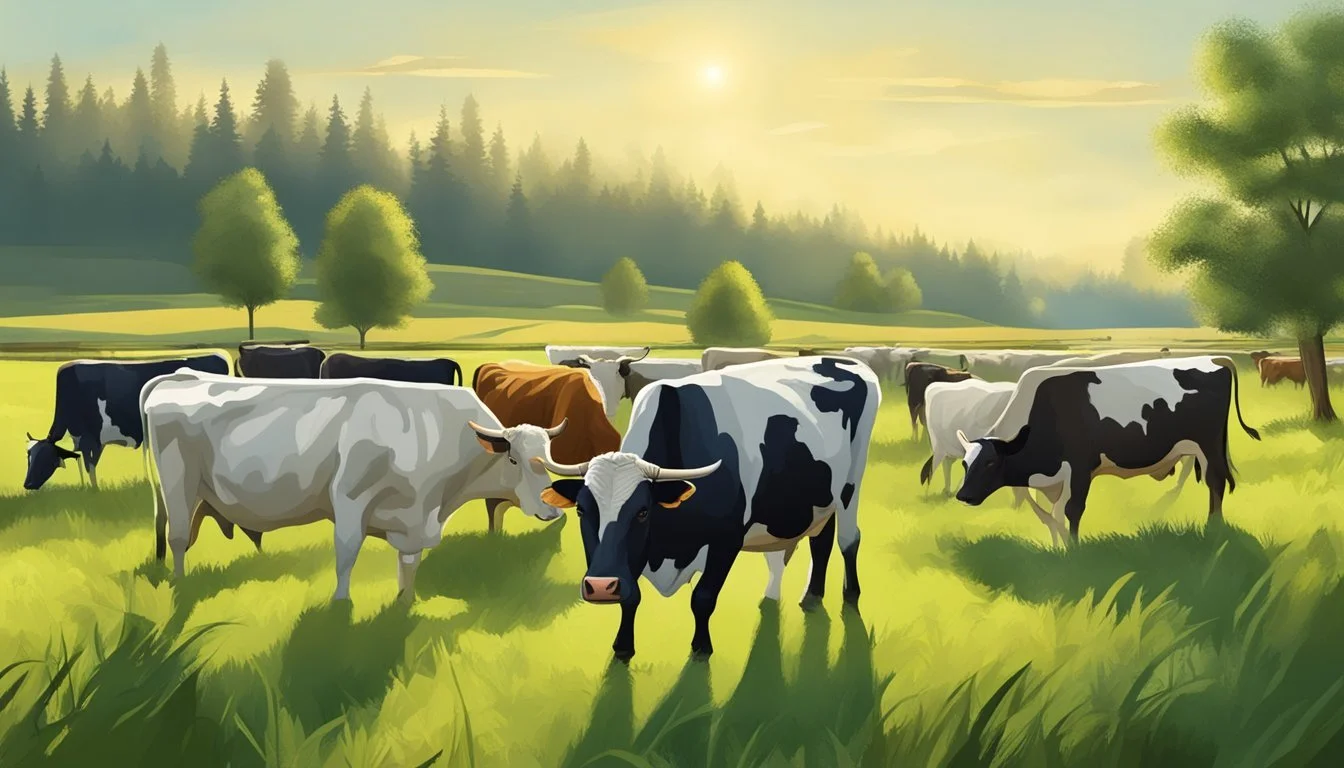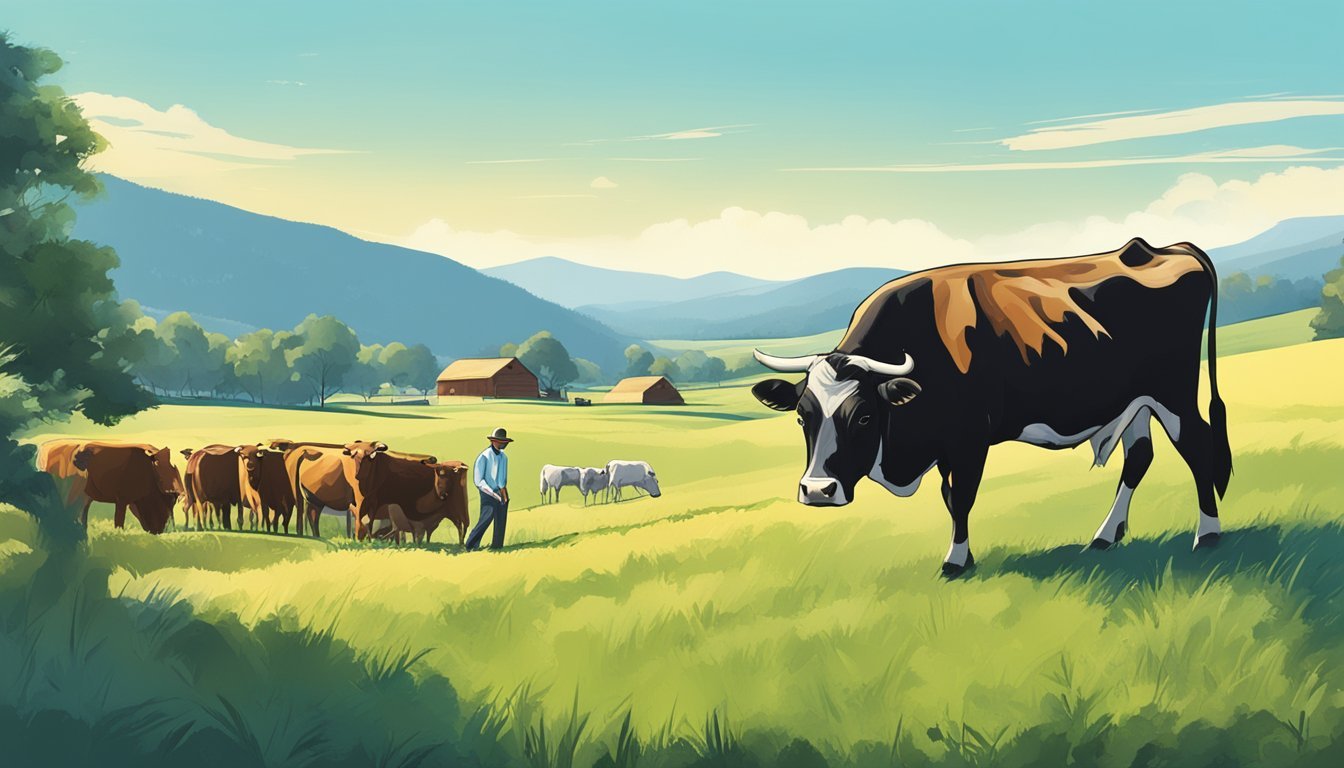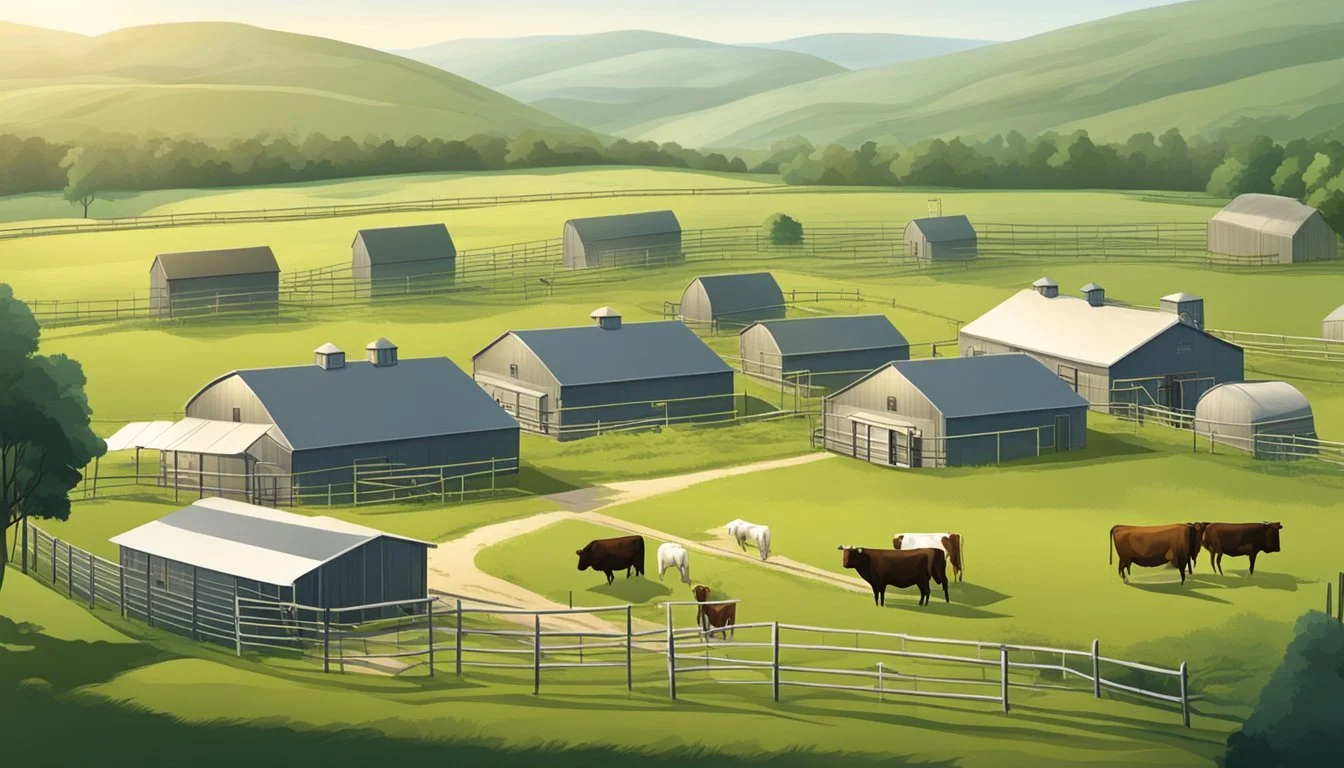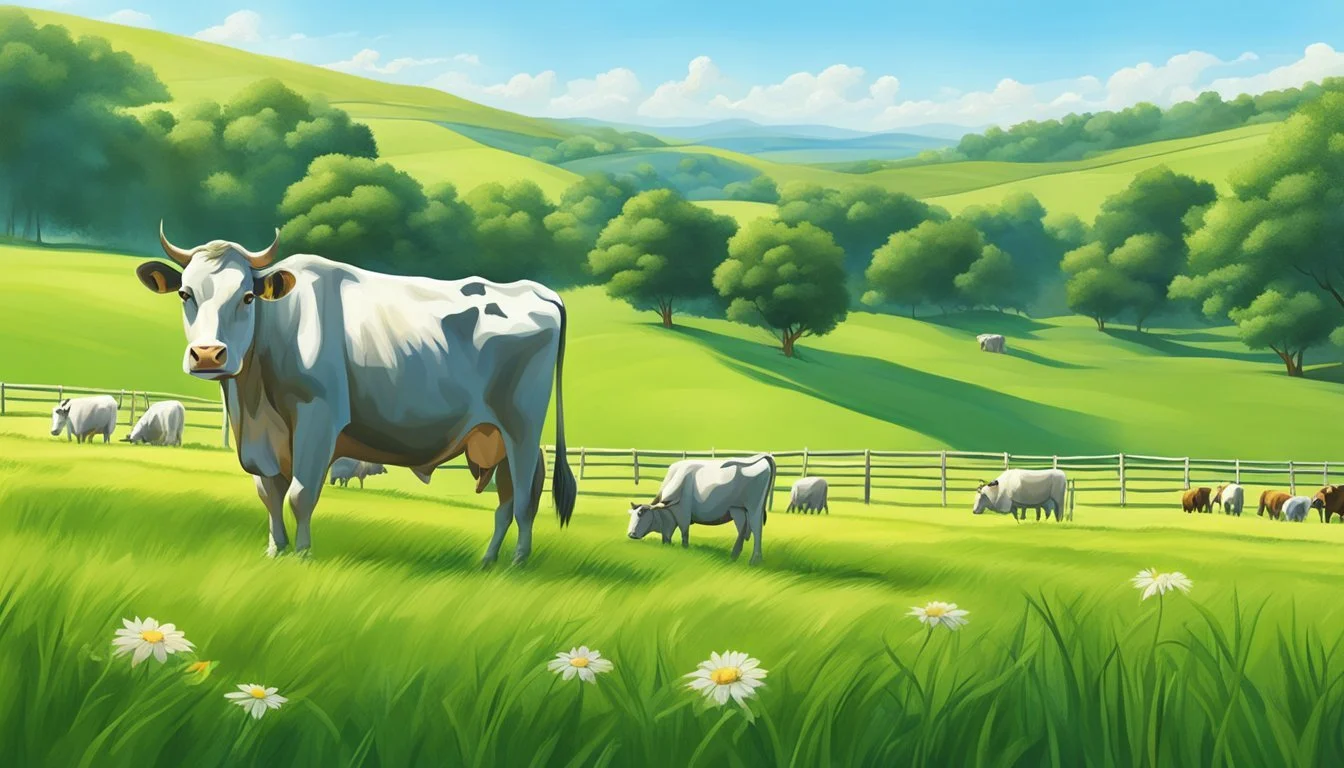What Are the Requirements for Organic Cattle Farming?
Key Standards and Practices Explained
Organic cattle farming is subject to stringent regulations to ensure that meat and dairy products labeled as "organic" adhere to specific standards. For ruminant livestock such as cattle, sheep, and goats, the organic certification process requires clear and consistent practices throughout the animals' lives. One of the fundamental requirements is that these animals have free access to certified organic pasture for the entirety of the grazing season, which must be at least 120 days, though this duration can vary according to the farm's geographic location and climate conditions.
Livestock health and well-being are pivotal in organic farming, with preventive healthcare practices taking precedence. The USDA organic regulations outline the need for livestock to be raised in living conditions that accommodate their natural behaviors, such as grazing on pasture, and mandate a diet composed of organic feed and forage. The avoidance of synthetic hormones, antibiotics, and genetically modified organisms (GMOs) is not only a rule but a foundational ethos of organic livestock management.
Furthermore, the integrity of organic cattle farming extends to transportation and slaughter practices, which are designed to minimize stress and discomfort for the animals. With the recent implementation of the Organic Livestock and Poultry Standards (OLPS), there has been an emphasis on refining and improving these standards to align with consumer expectations and ensure fair practices across the organic meat and dairy industries. These comprehensive regulations help maintain a level playing field for organic producers and afford consumers greater confidence in the organic label.
Overview of Organic Livestock Production
Organic livestock production adheres to a set of rigorous standards established to maintain the integrity and traceability of animal products labeled as organic. The United States Department of Agriculture (USDA) regulates these standards through the National Organic Program (NOP), ensuring that organic cattle farming respects both animal welfare and environmental sustainability.
Key Principles:
Animal Welfare: Livestock must have access to the outdoors, fresh air, water, sunshine, grass and pasture, and must be fed 100% organic feed.
Environmental Conservation: Farmers employ methods that preserve the ecosystem, including crop rotation and composted animal manures.
No Prohibited Substances: The use of antibiotics, growth hormones, and genetically modified organisms (GMOs) is strictly prohibited in organic cattle farming.
Certification Requirements:
Detailed records must be maintained for all management practices and materials used.
A third-party audit is conducted regularly to ensure compliance with organic standards.
These principles and requirements ensure that organic livestock products are produced in ways that support the health and welfare of the animals and provide benefits to the environment. The implementation of these standards levels the playing field for farmers and fosters fair competition in the market.
For more detailed information on these regulations, one could review the USDA's published regulations on organic livestock and poultry standards.
Organic Cattle Farming Standards
In organic cattle farming, strict regulations ensure the health and welfare of the livestock through natural practices. These standards emphasize proper nutrition, adequate pasture for grazing, humane living conditions, and adherence to certified organic production methods.
Feed and Nutrition
Organic cattle must be provided with a diet that meets their nutritional requirements while adhering to organic standards. All feed, including grain, forage, and hay, must be certified organic, meaning they cannot contain synthetic additives or genetically modified organisms (GMOs). At least 30% of their dry matter intake (DMI) should come from grazing on organic pasture, and the feed must contain sufficient protein and nutrients to maintain the overall health and quality of the livestock.
Pasture and Grazing Requirements
Pasture-based organic cattle farming mandates access to pasture throughout the grazing season, which must be at least 120 days per year. Organic livestock feed needs must be met primarily through pasture during this period. The pasture must be managed organically, and the cattle must be actively grazing to fulfill their nutritional requirements. This not only supports their diet but also encourages natural behavior and well-being.
Health and Living Conditions
To ensure cattle's health, living conditions must promote physical and psychological well-being, preventing diseases and stress. Practices that promote breeding and defense against parasites without relying on antibiotics or growth hormones are integral. Living conditions must include shelter, space, and the ability to engage in natural behaviors.
Organic Regulations Compliance
Every aspect of organic cattle farming must comply with USDA organic regulations under the National Organic Program regulation. Producers must document all practices and substances used on the farm to maintain compliance. Regular inspections certify that farmers meet the organic regulations, and any violation can lead to decertification.
The standards outlined are essential for the integrity of organic cattle farming, ensuring that products bearing the organic label adhere to the highest quality and ethical standards.
Certification and Organic Standards
Organic cattle farming is a strictly regulated industry, which adheres to specific requirements in order to obtain certification and use the USDA organic label. These requirements ensure that livestock are raised according to national organic standards, with an emphasis on natural living conditions and organic management practices.
National Organic Program Overview
The National Organic Program (NOP) is a regulatory program housed within the USDA Agricultural Marketing Service. It is responsible for setting the national organic standards that define how foods and livestock must be produced to be considered organic. The NOP includes requirements for organic farming practices that promote ecological balance and conserve biodiversity.
Organic Certification Process
For a cattle farm to be certified organic, it must follow a rigorous certification process. This involves developing an organic system plan that outlines how the farm will comply with the NOP requirements. The plan includes organic management practices addressing soil fertility, feed, health care, and access to pasture. A USDA-accredited certifying agent must then review the plan and audit the farm to ensure compliance with the organic standards.
Rulemaking and Public Comments
The evolution of organic livestock standards is an ongoing process that involves rulemaking activities. Proposed rules are published in the Federal Register to allow stakeholders to participate in public comments. The National Organic Standards Board, an advisory board made up of organic industry experts, reviews these comments and makes recommendations. This transparent process, which includes strengthening organic enforcement, ensures that the organic standards evolve to reflect best practices and industry innovations while maintaining consumer trust in the organic label and organic seal.
Organic Livestock Feed Guidelines
In organic cattle farming, adhering to stringent feed guidelines is crucial for maintaining certification and ensuring the health of the livestock. These rules regulate everything from the ingredients of the feed to the management strategies employed.
Feed Ingredients and Quality
Organic cattle feed must consist of certified organic ingredients, including grains, forages, and supplements that meet all organic regulations. For ruminants, a minimum of 30% of the dry matter intake must come from certified organic pasture during the grazing season. The feed should also supply adequate nutrients, fiber, minerals, potassium, sulfur, and nitrogen for the cattle's well-being.
Feed Management Strategies
The feeding program for organic cattle must support natural behavior and health. Feed management includes strategies to prevent overgrazing, ensure proper dry matter intake from pasture, and supplement rations with organic hay, grain, and corn silage as needed to meet the animals' nutritional requirements. Continual access to pasture is mandatory for ruminants throughout the grazing season.
Standards for Specific Types of Feed
For organic cattle farming, specific types of feed, such as grain, hay, and corn silage, must be derived from plants grown without prohibited substances. Any mineral supplements must come from natural sources on the National List of Allowed and Prohibited Substances. The use of synthetic and non-organic feed is strictly prohibited.
Prohibited Substances in Feed
Feed for organic cattle must not contain any antibiotics, hormones, or genetically modified organisms (GMOs). The National List of Allowed and Prohibited Substances outlines specific prohibitions regarding feed additives and supplements. Careful adherence to this list is essential for organic certification and the integrity of the organic cattle farming industry.
Animal Welfare and Livestock Handling
The Organic Livestock and Poultry Standards require specific practices to ensure animal welfare throughout the lifecycle of the animal, especially during transport and slaughter. These practices are crucial to guarantee that the living conditions and handling meet the organic certification requirements, reflecting on the quality of the organic meat produced.
Transport and Slaughter Processes
Transport processes are a critical aspect of animal welfare in organic cattle farming. They must ensure minimal stress and maintain animal welfare during the journey. For organic livestock destined for slaughter, specific rules are laid down to maintain organic integrity.
Handling practices for these animals, during and after transport, must prevent undue stress, thereby promoting both their well-being and the quality of livestock products. Furthermore, during slaughter, the conditions under which this is carried out must adhere to the established organic standards, which advocate for humane termination methods that minimize suffering.
Duration of transport: Animals must be fit for transport, and considerations are made for journeys that exceed eight hours.
Slaughter methods: These should align with organic management principles to ensure minimal stress and humane treatment.
By adhering to these standards, organic meat producers help to assure consumers that the products they purchase are sourced from systems that prioritize animal welfare.
Environmental Impact and Land Use
In the realm of organic cattle farming, attention to environmental impact and the application of land use practices such as soil fertility and crop rotation play pivotal roles. The methodologies implemented in organic systems sharply contrast with those of conventional livestock systems—emphasizing ecological balance and long-term sustainability.
Soil Fertility and Crop Rotation
Organic farming necessitates that one maintains soil fertility to uphold stringent organic standards. It involves a well-planned synergy between livestock and crop components of the farm. Crucial to this is the use of manure as a natural fertilizer, which enriches the soil by returning nutrients and improving soil structure. This practice diminishes the need for synthetic fertilizers, thereby reducing the overall environmental impact.
Furthermore, organic cattle farmers must implement crop rotation, which supports the health of the soil and aids in pest and weed management. Rotating different kinds of organic crops not only prevents nutrient depletion but also improves biodiversity and resilience of the ecosystem. When compared to conventional livestock systems, which may have a more homogeneous approach to land use, organic farming seeks to work with natural processes and cycles to preserve environmental integrity.
Market Considerations for Organic Cattle Products
The organic cattle market is shaped by evolving demand trends, strict regulatory requirements for labeling and marketing, and the distinct differences between organic and conventional livestock products.
Consumer Demand and Market Trends
Consumer interest in organic dairy and organic meat continues to grow, driven by concerns for animal welfare, environmental impact, and health benefits. Data shows a consistent rise in the purchase of organic products such as milk, beef, and dairy items. This has prompted organic cattle farmers to adapt to the increasing demand, ensuring that organic cattle farming methods meet the expectations of well-informed consumers. Competitive markets also influence pricing and availability, making it essential for producers to maintain a balance between authenticity and market pressures.
Labeling and Marketing Organic Products
To market cattle products as organic, farmers must adhere to strict guidelines to obtain the organic label. The organic seal is a critical marketing tool that assures consumers of the product's compliance with organic livestock production standards. Labeling must accurately represent the contents, with clear indications if the product is 100 percent organic or just contains organic ingredients. Mislabeling can lead to penalties and erode consumer trust, making adherence to these standards crucial for any entity looking to market organic dairy products or organic meat.
Comparison with Conventional Livestock Products
Organic cattle products are often marketed as healthier and more ethically sustainable than their conventional counterparts. Unlike conventional livestock production which can involve growth hormones and antibiotics, organic cattle farming prohibits such substances. Furthermore, organic livestock products must meet specific animal welfare and feed requirements. As a result, they often command higher prices in the market, justified by the rigorous standards of organic beef, lamb, goat, and pork production. These premiums reflect both the increased cost of production and the perceived benefits of organic farming practices.
Nutrient Management in Organic Cattle Diets
Proper nutrient management is essential in organic cattle farming to ensure that cattle receive a balanced diet and maintain optimal health and productivity. An emphasis on macronutrients is crucial to support growth, energy, body condition, and overall wellness of the cattle.
Macronutrient Balance and Requirements
Managing macronutrients such as proteins, fibers, and minerals in the diet of organic cattle is essential to fulfill their nutritional requirements. Proteins are fundamental for growth and repair in cattle, necessitating sources that are both high-quality and organic. For instance, legumes and forage are organic protein sources that support the dietary needs and development of cattle.
On the other hand, fibers are imperative for proper digestion and gut health. Organic cattle diets frequently rely on high fiber foods such as pasture, hay, and silage to maintain a healthy digestive system. Ensuring that sufficient fiber is included in the cattle's diet also contributes to a favorable body condition, crucial for organic milk and meat production standards.
As for minerals, which include essential elements like calcium, phosphorus, and magnesium, they must be carefully managed in organic cattle diets. Mineral imbalances can have significant effects on cattle health. These nutrients are obtained from both pasture grazing and supplemental organic mineral sources to meet the cattle's needs. The goal is not just to provide the minimum nutritional requirements but also to achieve an equilibrium that supports both the animal's well-being and the farm's sustainability.
Moreover, energy density in the diet is linked to the cattle's ability to perform and thrive. Organic cattle farming opts for natural, organic feedstuffs to supply necessary energy levels, ensuring that the diet supports the ongoing energy demands of the cattle, particularly during stages of lactation or growth. Adequate energy intake is directly related to maintaining an ideal body condition score in cattle, which is indicative of good health and proper nutrition in an organic system.
Production Challenges and Best Practices
In the realm of organic cattle farming, adhering to strict organic management protocols is paramount. Farmers must maintain consistency in their practices to meet organic standards and reduce stress in animals that could lead to increased susceptibility to diseases and parasites.
Managing Diseases and Parasites
Preventive health measures are the cornerstone of controlling diseases and parasites in organic cattle farming. This includes:
Quarantine procedures for new or sick animals to prevent the spread of disease.
Rotational grazing to disrupt the life cycles of parasites.
Selection of resistant breeds which have natural resistance to certain conditions.
Farmers must also prioritize the living conditions of their cattle. Good ventilation, clean water, and appropriate space reduce stress and the risk of disease transmission. Regular health checks and rapid response to signs of illness are essential to maintain herd health within organic farming guidelines. It is important to work closely with a veterinarian who is experienced in organic livestock practices to ensure that all interventions align with organic standards.
Regulations and Industry Standards
In the domain of organic cattle farming, adherence to rigorous regulations and industry standards is paramount. The United States Department of Agriculture (USDA) sets forth comprehensive policies that define the framework for organic livestock producers.
USDA Organic Regulation Updates
USDA Organic Regulations have been recently updated to refine the requirements for organic cattle farming. Notably, organic ruminant livestock, which includes cattle, are mandated to have free access to certified organic pasture during the entire grazing season of not less than 120 days. These updated standards are a reflection of the USDA's commitment to ensuring the integrity of organic livestock products.
The National Organic Standards Board, acting in an advisory capacity to the USDA, contributes to the formulation of these standards, while the National Organic Program Regulations enforce them. The regulations delineate clear criteria regarding feed, health care, and living conditions that must be met to achieve and maintain organic certification.
Furthermore, the establishment of the new Organic Livestock and Poultry Standards by the USDA aims to create consistent and transparent practices across the industry. It ensures fairness and competitive markets for organic livestock farmers, ranchers, and businesses who are devoted to following these stringent standards.
The dedication to maintaining specific living conditions, prohibiting the use of antibiotics and hormones, and requiring organically produced feed is indicative of the USDA's comprehensive approach to organic certification. These standards play a crucial role in the labeling and representation of livestock products as organic, setting a clear expectation for producers and consumers alike.
Summary & Future Outlook
In the realm of organic cattle farming, stringent regulations govern the process from pasture to product. Farmers must adhere to requirements ensuring that cattle consume 100 percent certified organic feed, with exceptions only for essential minerals and vitamins. Additionally, the maintenance of cattle health is paramount, with an explicit ban on antibiotics and added growth hormones. The animals must graze on certified organic land, upholding the organic crop production standards throughout their lives.
The USDA Organic Livestock and Poultry Standards (OLPS) final rule epitomizes a commitment to clear, strong, and consistent standards for organic livestock and poultry production. This framework not only supports organic livestock farmers but also aims at fostering fairer and more competitive markets for their products.
Looking ahead, further future development in the organic sector is likely to rely on advances in sustainable agriculture practices and continued governmental support through programs like the Organic and Transitional Education and Certification Program (OTECP) and the Organic Dairy Marketing Assistance Program (ODMAP). These initiatives are designed to bolster the market presence of organic products and assist growers and producers in meeting the rigorous standards set forth for organic certification.
Investments in research and development are critical for continuous innovation in organic farming practices. They are expected to play a key role in meeting the growing consumer demand for organic products. As the industry evolves, the regulatory landscape will adapt, potentially introducing new standards to refine and enhance the organic certification process.










